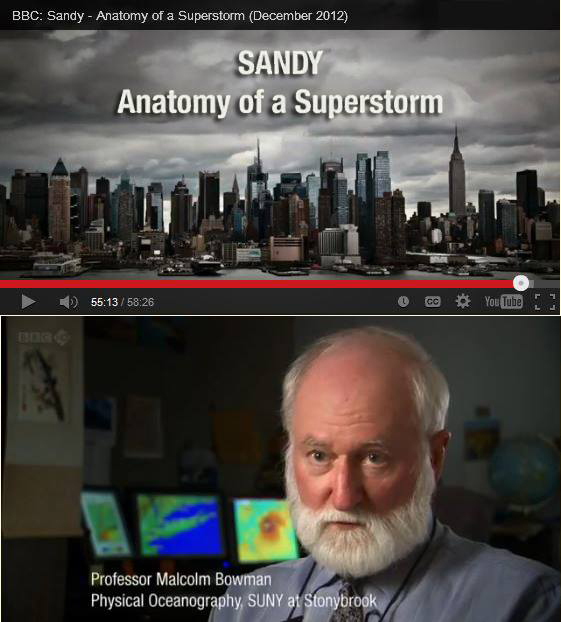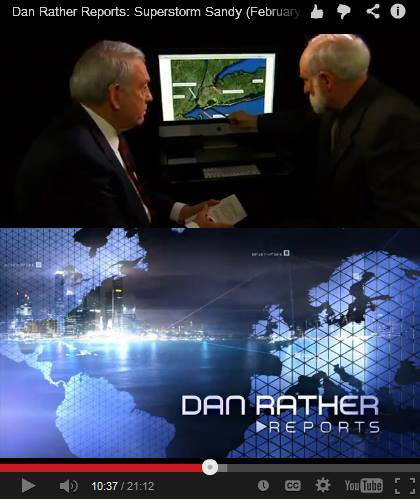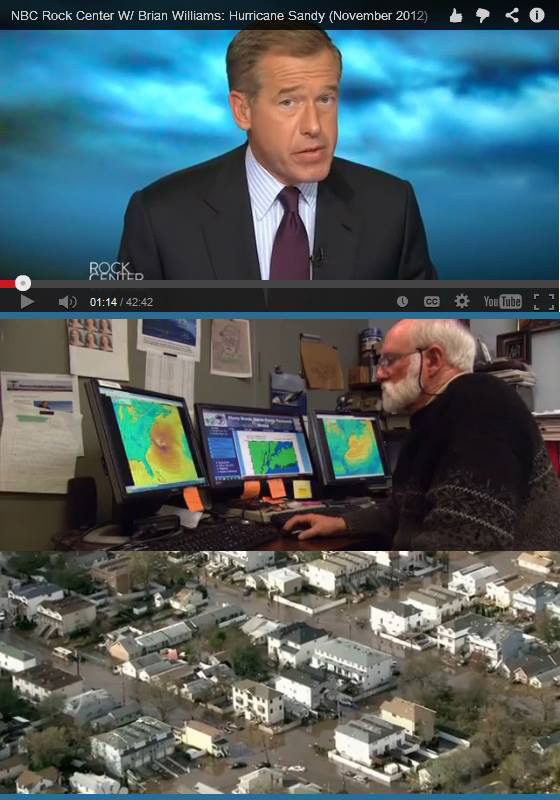For more than a decade, New York Sea Grant has funded studies of Malcom Bowman's as well as other investigators in the Stony Brook Storm Surge Research Group, for which Bowman is the lead. Bowman is a professor of physical oceanography at Stony Brook University's School of Marine and Atmospheric Sciences.
Malcolm Bowman vs. The Storms
Stony Brook University Researcher is a Man of the Year for raising awareness of dangers
Published in: The Village Times Herald
By Andrea Moore Paldy
Stony Brook, NY, December 26, 2013 - Professor Malcolm Bowman is a man ahead of his time. After years of modeling and predicting storm surges, his concerns about the threats they pose to low-lying areas of New York City, New Jersey and Long Island were validated with the devastation caused by Hurricane Sandy.
Now Bowman, a New Zealander who heads the Stony Brook Storm Surge Research Group at Stony Brook University, is the person to whom everyone wants to speak.
"Policymakers are beginning to sit up and take notice," said New York state Assemblyman Steve Englebright, who has known Bowman since 1971, when they both started teaching at SBU. Bowman, he added, "is probably the leading voice in this country for making the structural adjustments to protect our coastal areas."
Bowman has been studying oceanography around Long Island's coasts since the early 1970s. In the eight years since Hurricane Katrina, however, he has studied the protective barrier systems of St. Petersburg, Russia; the Netherlands; and other European areas situated on low-lying lands. Bowman knew that with rising seawater and a growing frequency of severe storms, what had occurred in New Orleans could happen in New York.
The New York Sea Grant program is funding the research group's work on coastal defense and protection. Two sets of barrier gates designed to shield the New York metropolitan area could run between New Jersey and Far Rockaway and the Throgs Neck crossing. They would remain open for "years on end" to allow tidal flow and the passage of ships, Bowman said. They would be closed only during a serious storm, with vertical panels coming down into the water and channel gates swinging closed like "saloon doors."
Proposed as multipurpose structures that could generate revenue, the barriers could house a toll interstate on top, possibly a light rail to JFK and Newark airports and marinas on the inside, Bowman said. The estimated $20 billion to $25 billion price tag would still cost less than the $65 billion in damage wrought by Hurricane Sandy in October 2012.
Bowman believes that political leaders should agree that the aftermath of Hurricane Sandy was "so terrible it must never happen again," and work together at local, state and regional levels to find a way to build and pay for the life- and property-saving barriers. He also recommends building sand dunes as natural barriers.
For his persistence in research and passing on his knowledge of rising waters in an understandable way, Malcolm Bowman is a Man of the Year.
"As a scientist, I think he's extremely creative," said Larry Swanson, a longtime friend and colleague. Swanson is the associate dean of the SBU School of Marine and Atmospheric Sciences and director of waste reduction and management there.
Swanson, who said that he often plays the "bad guy" by writing about the potential environmental consequences of the gates, is co-authoring a book with Bowman about the natural history of Stony Brook. Though Swanson has some concerns about the impact of the barrier gates on marine life and about which coastal populations would be protected, he said he admires the way Bowman has shared his scientific knowledge with politicians and the community "and has tried to encourage others to participate in protecting the environment."
Bowman is also a founding member of the Friends of Flax Pond. The nonprofit organization sponsors research and educational activities to preserve the salt-water marsh just north of Stony Brook Village and its ecosystem.
Beyond his research and advocacy, Bowman is a beloved professor. His research assistant, Alexandra Santiago, has worked for him for two years. She started out as a student in his freshman seminar in 2009. "Everyone loves Professor Bowman," she said.
"He doesn't just teach in the classroom," Englebright said. "He is an exemplary example of a professor who likes to get his students up to their knees in their work in a very real sense."
As adviser to the Stony Brook chapter of Global Water Brigades, Bowman has taken students to Honduras to dig trenches for a potable water reticulation system. He also plays a role in Earthstock, the university's annual week-long Earth Day celebration.
Bowman is thoughtful, Swanson said. He has always made students, especially undergraduates from other countries, feel at home. "He takes everybody into his house," Swanson said.
"Even though he's a prestigious scholar, he's someone you can just talk to and not feel intimidated by," Santiago said, "and a lot of students like that."
Photos:

On Monday, October 29, 2012, Superstorm Sandy made landfall in the Metro NY region. A month later, BBC premiered an hour-long documentary on the "Anatomy of a Superstorm," for which Stony Brook Storm Surge Research Group investigator Malcolm Bowman and others provided insights on Sandy and where we should go moving forward when it comes to being prepared for severe storms.
"The time has come for a series of storm surge barriers to protect New York, northern New Jersey, and parts of western Long Island Sound from this ever happening again," said Bowman. While the barriers would take decades to build and cost at least $10 billion, Sandy has already tallied over $62 billion in economic losses, making it the second most costly storm event in U.S. history. Bowman urges, "This is a serious proposal that the City now should investigate."
Six months later, in May 2013, Bowman followed up with the BBC for a four-and-a-half-minute radio interview. Both the audio file and the entire video documentary are available to, respectively, listen to and watch via New York Sea Grant's related news item, "
On YouTube: BBC - Superstorm Sandy."

Post-Superstorm Sandy, there are many thoughts by researchers and decision-makers alike on which management response route New York should take: one of resistance (one of precaution and prevention), resilience (bringing back our communities back to their pre-storm state) or re-alignment (evolve and reconfigure what, how and when to rebuild).
"I cannot tell you when the next big one will be," said Stony Brook University School of Marine and Atmospheric Sciences oceanography professor and storm surge expert Dr. Malcolm Bowman. "But it will come. It's inevitable in the long term. And the sooner we come to that realization, the better. Because the longer you put it off, the more damage and destruction and heartache we're going to face."
In February 2013, Bowman provided these and other comments as part of an in-depth discussion with journalist Dan Rather, who filed his "Dan Rather Reports" post-Sandy special report. Check out the full video as well as some of the transcript via New York Sea Grant's related news item, "
On YouTube: Dan Rather Reports - Superstorm Sandy."

"Hurricane Sandy is a wake-up call to all of us in this city and on Long Island," Malcolm Bowman, professor of physical oceanography at Stony Brook University, told NBC News reporter Richard Engel, who surveyed the damage from a police helicopter Thursday, November 1, 2012, just a few short days after Sandy hit the metro NY area. "That means designing and building storm surge barriers like many cities in Europe already have."
New York Sea Grant's related news item, "
On YouTube: NBC Rock Center W/ Brian Williams: Hurricane Sandy," includes the full video as well as some of the transcript content.
More Info: New York Sea Grant
New York Sea Grant (NYSG), a cooperative program of Cornell University
and the State University of New York, is one of 33 university-based
programs under the National Sea Grant College Program (NSGCP) of the
National Oceanic and Atmospheric Administration (NOAA). The NSGCP
engages this network of the nation’s top universities in conducting
scientific research, education, training and extension projects designed
to foster science-based decisions about the use and conservation of our
aquatic resources. Through its statewide network of integrated
services, NYSG has been promoting coastal vitality, environmental
sustainability, and citizen awareness about the State’s marine and Great
Lakes resources since 1971.
For updates on Sea Grant activities:
www.nyseagrant.org has RSS,
Facebook,
Twitter, and
YouTube links. NYSG also offers a free e-list sign up via
www.nyseagrant.org/coastlines for
NY Coastlines, its flagship publication, which, in 2014, merges with the program's e-newsletter,
Currents.
NY Coastlines is published several times a year.